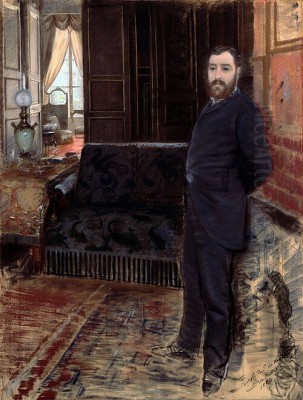
Giuseppe De Nittis stands as one of the most significant Italian painters of the 19th century, a pivotal figure who successfully navigated the vibrant, often competing, art worlds of Naples, Florence, Paris, and London. Born on February 25, 1846, in Barletta, located in the southern Italian region of Puglia, and passing away prematurely on August 21, 1884, in Saint-Germain-en-Laye, France, De Nittis forged a unique artistic identity. He masterfully blended the academic traditions he initially encountered with the burgeoning realism of the Italian Macchiaioli and the revolutionary light and dynamism of French Impressionism. His work, celebrated for its elegance, atmospheric sensitivity, and depiction of modern life, earned him international acclaim during his lifetime and continues to resonate today. He remains particularly renowned for his captivating views of Paris and London, capturing the fleeting moments and distinct character of these bustling metropolises.
Early Life and Artistic Awakening in Naples
Giuseppe De Nittis hailed from a prosperous family of landowners in Barletta, which afforded him a good education from a young age. His artistic inclinations became apparent early on. At the age of fourteen, following the path of many aspiring artists from the Italian South, he moved to Naples with his brother. Naples, at that time, was a major cultural center with a long artistic heritage. He enrolled at the Naples Academy of Fine Arts (Accademia di Belle Arti di Napoli) to receive formal training.
However, De Nittis possessed a rebellious spirit and chafed against the rigid academicism taught at the Academy. His independent nature and disregard for strict disciplinary rules led to his expulsion in 1863. This event, rather than hindering his career, proved to be a catalyst. Freed from academic constraints, De Nittis sought out more progressive artistic circles. He became associated with a group of artists known as the Scuola di Resina (School of Resina), sometimes also referred to as the Portici School, who gathered near Naples.
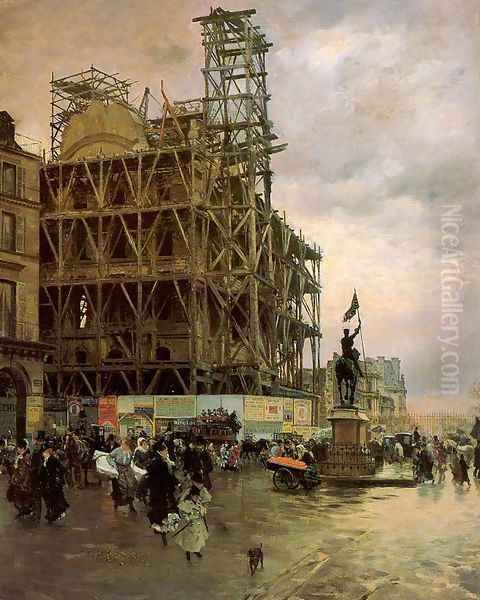
This group, which included painters like Adriano Cecioni and Marco De Gregorio, advocated for painting directly from nature (en plein air) and focused on capturing the effects of light and atmosphere with a greater sense of realism. Their approach was closely aligned with the principles of the Macchiaioli movement, centered primarily in Florence, which emphasized depicting reality through 'macchie' – patches or spots of color and chiaroscuro. Although based near Naples, De Nittis absorbed these innovative ideas, moving decisively away from historical or mythological subjects towards contemporary life and landscape. His early works from this period already show a keen interest in natural light and direct observation. In 1864, he officially launched his career by exhibiting two paintings at the Naples Promotrice exhibition.
The Move to Paris: Embracing Modernity
In 1867, seeking broader horizons and greater opportunities, De Nittis made the pivotal decision to move to Paris. Paris was undeniably the epicenter of the art world in the 19th century, a magnet for ambitious artists from across Europe. Arriving in the French capital, he immersed himself in its dynamic artistic milieu. A crucial step in establishing his career was forming a relationship with the influential art dealer Adolphe Goupil. Goupil's gallery represented many successful artists and provided De Nittis with valuable exposure and commercial stability, allowing him to focus on his art.
De Nittis began exhibiting his works at the prestigious Paris Salon, the official, juried exhibition that was the primary venue for artists seeking recognition and patronage. Success at the Salon was critical for building a reputation. De Nittis achieved this relatively quickly. His painting Che Freddo! (meaning "How Cold!" or "It's Freezing!"), depicting figures huddled against the winter chill, was well-received at the Salon of 1874, marking a significant moment in his rise within the Parisian art scene.
His personal life also flourished in Paris. In 1869, he married Léontine Lucile Gruelle, a Parisian woman who became not only his wife but also a frequent subject in his paintings and an active participant in their vibrant social life. Settling in Paris, De Nittis adapted his style, absorbing the influences around him while retaining his distinct Italian sensibility. He became known for his elegant depictions of modern Parisian life, capturing its boulevards, parks, and social rituals with a fresh and observant eye.
De Nittis and the Impressionist Circle
Giuseppe De Nittis occupied a fascinating position relative to the Impressionist movement. While deeply connected to many of its key figures, his relationship with the group was complex and somewhat distinct. His arrival in Paris coincided with the formative years of Impressionism, and he quickly formed friendships with several leading avant-garde painters, most notably Edgar Degas, who became a close and supportive friend. He also knew Claude Monet and Édouard Manet, whose works he admired and even purchased for his personal collection.
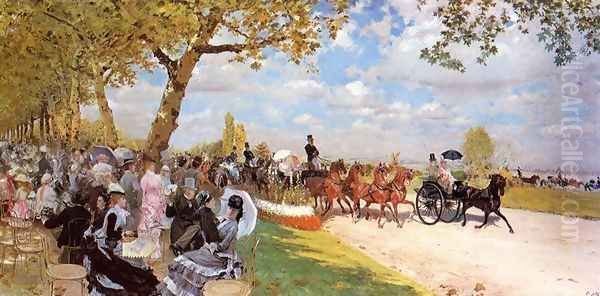
His connection was formalized in 1874 when Degas invited him to participate in the First Impressionist Exhibition, held at the studio of the photographer Nadar. This exhibition was a radical break from the official Salon system and is considered a landmark event in modern art history. De Nittis was the only Italian artist invited to participate, a testament to the regard in which he was held by the core members of the group. He exhibited five works, showcasing his interest in contemporary urban scenes and atmospheric effects.
Despite this participation, De Nittis never fully aligned himself with the Impressionist group's more radical rejection of the Salon. He continued to submit works to the official Salon throughout his career, seeking mainstream recognition and success, which he largely achieved. Some contemporary critics, while acknowledging his talent, occasionally found his work perhaps "too polished" or closer to Salon aesthetics than the rougher, more spontaneous brushwork often associated with Monet or Camille Pissarro. However, his friendships remained strong, particularly with Degas, and his work clearly absorbed Impressionist principles, especially the focus on capturing fleeting light, movement, and the essence of modern experience. He shared with artists like Gustave Caillebotte a fascination with the perspectives and dynamism of the modern city.
A Unique Style: Blending Tradition and Innovation
The hallmark of Giuseppe De Nittis's art is its sophisticated synthesis of diverse influences, resulting in a style that was both modern and accessible. His artistic DNA contained elements from his Italian roots, particularly the Macchiaioli emphasis on strong tonal contrasts and painting outdoors, combined with the French Impressionists' preoccupation with light, color, and contemporary subject matter. Crucially, he filtered these modern tendencies through a lens of academic draftsmanship and compositional structure learned early in his career and maintained through his engagement with the Salon.
Unlike some Impressionists who completely dissolved form in light and color, De Nittis often retained a clearer definition of figures and objects, grounding his scenes with solid drawing. His brushwork could be varied – sometimes loose and suggestive, capturing the immediacy of a moment, other times more controlled and refined, particularly in commissioned portraits or more finished Salon pieces. This adaptability allowed him to appeal to a broader audience, including collectors who appreciated modern subjects but preferred a degree of traditional finish.
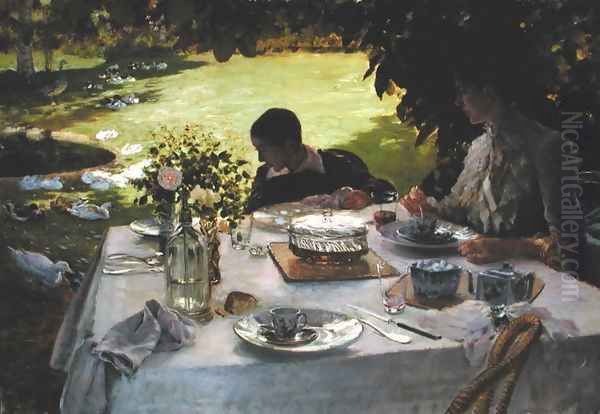
He demonstrated exceptional skill in rendering different atmospheres and weather conditions – the crisp light of a sunny Parisian afternoon, the damp haze of London fog, the delicate quality of snowfall, or the warmth of an Italian landscape. His palette could range from the bright, high-keyed colors associated with Impressionism to more subdued tonal harmonies using blacks, greys, and browns, reminiscent of Manet or even earlier realist traditions. This stylistic flexibility, bridging the perceived gap between academic art and the avant-garde, distinguished him from many of his contemporaries like the Belgian Alfred Stevens or the Frenchman James Tissot, who also depicted elegant modern life but often with a different, sometimes more narrative or anecdotal, focus.
Capturing the Urban Spectacle: Paris and London
De Nittis is perhaps best remembered for his vibrant and atmospheric depictions of city life, particularly in Paris and London. He excelled at capturing the energy, elegance, and fleeting moments of the modern metropolis during a period of rapid transformation. His Parisian scenes often feature the wide boulevards designed by Haussmann, bustling with carriages, pedestrians, and fashionably dressed figures. Works like Place des Pyramides (c. 1875) exemplify his ability to convey the scale and dynamism of the city, using perspective and lively brushwork to suggest movement and the interplay of light and shadow on buildings and figures.
He didn't just paint the grand public spaces; he also captured more intimate moments of urban leisure – figures relaxing in parks like the Bois de Boulogne, attending the races at Longchamp (Return from the Races, c. 1875), or enjoying social gatherings. These paintings often highlight the fashions and social customs of the Belle Époque, observed with a keen and sophisticated eye. His wife, Léontine, frequently appears in these scenes, embodying the stylish Parisian woman.
De Nittis also made several trips to London, and his paintings of the British capital are equally celebrated, particularly for their masterful rendering of its unique atmosphere. He seemed fascinated by the effects of fog, rain, and the softer, more diffused light of London. Works depicting iconic locations like Westminster Bridge or Trafalgar Square often emphasize these atmospheric conditions, using a subtle palette and fluid brushwork to convey the damp air and hazy vistas. These London paintings stand as some of the most evocative images of the city produced in the late 19th century, capturing its grandeur and its moody weather with equal skill.
Landscapes: From Vesuvius to the Countryside
While renowned for his urban scenes, Giuseppe De Nittis maintained a deep connection to landscape painting throughout his career, a passion rooted in his Italian origins and his early experiences painting en plein air near Naples. His landscapes often provide a contrast to the bustle of his city views, showcasing his sensitivity to nature and his ability to capture the specific character of different locales.
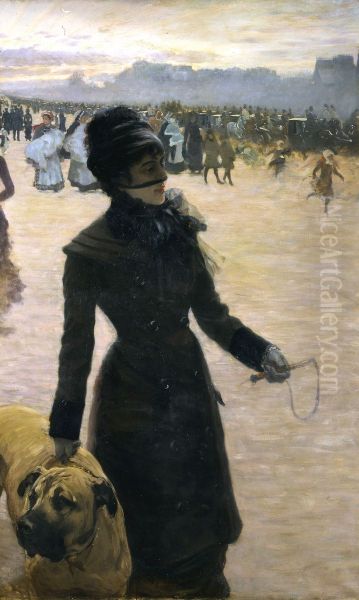
Among his most iconic landscapes are his depictions of Mount Vesuvius. He painted the famous volcano numerous times, under varying conditions of light and weather. These works range from dramatic views emphasizing the volcano's imposing silhouette against the sky to more tranquil scenes incorporating the surrounding countryside and coastline. His Vesuvius paintings demonstrate his skill in rendering geological forms and atmospheric perspective, capturing both the beauty and the latent power of the Neapolitan landmark.
His travels also took him to other parts of Italy and the European countryside, providing further subjects for his landscape work. The Road to Brindisi (1872) is a notable example, showcasing a sun-drenched Italian rural scene rendered with the bright palette and attention to light characteristic of his mature style. He also painted landscapes reflecting his origins, such as views of his hometown, Barletta, often focusing on the relationship between the land, the sea, and the effects of southern Italian light. Whether depicting the dramatic Neapolitan coast, the rolling hills of the Italian countryside, or the parks on the outskirts of Paris, De Nittis approached landscape with the same observational acuity and sensitivity to light that defined his urban paintings.
The Allure of Pastel
In the later part of his career, Giuseppe De Nittis increasingly turned to working with pastels, alongside his oil painting. This medium offered him different possibilities for capturing immediacy, texture, and subtle light effects. His exploration of pastel coincided with a broader revival of interest in the medium among artists in Paris during the 1870s and 1880s, partly championed by his friend Edgar Degas, who became a renowned master of pastel.
Pastel allowed De Nittis to work quickly, making it ideal for capturing fleeting moments, changing light conditions, or sketching ideas en plein air. The dry, powdery nature of pastel sticks enabled him to achieve luminous color effects and delicate atmospheric transitions. He used pastels for a variety of subjects, including landscapes, portraits, and scenes of modern life. His pastel works often possess a remarkable freshness and spontaneity, showcasing his confident draftsmanship and his sophisticated understanding of color harmony.
His portraits in pastel are particularly noteworthy, often capturing the sitter's likeness and personality with intimacy and elegance. He depicted his wife Léontine, their son Jacques, and friends within their social circle. The medium lent itself well to rendering the textures of fabrics, the softness of skin, and the play of light on surfaces. De Nittis's embrace of pastel demonstrated his ongoing willingness to experiment with different techniques and materials, further enriching his artistic output and contributing to the medium's resurgence in popularity during the late 19th century.
Key Works and Masterpieces
Giuseppe De Nittis's oeuvre includes numerous works that are considered highlights of his career and important examples of late 19th-century European painting. While a comprehensive list is extensive, several key pieces stand out for their artistic quality, historical significance, or representation of his signature style:
Place des Pyramides, Paris (c. 1875): A quintessential Parisian scene capturing the bustling energy of the city square, noted for its dynamic composition, depiction of modern life (carriages, pedestrians, architecture), and masterful handling of light and atmosphere.
Westminster Bridge, London (or similar London scenes, e.g., Trafalgar Square, c. 1878): Representative of his London period, these works excel in capturing the city's unique foggy or damp atmosphere, using subtle tonal variations and fluid brushwork.
Return from the Races (c. 1875): Depicting the fashionable crowd at the Longchamp racecourse in Paris, this work showcases De Nittis's skill in rendering elegant figures, contemporary fashion, and the social rituals of the Parisian elite.
Breakfast in the Garden (c. 1883-84): A charming, light-filled scene, likely featuring his wife and son, exemplifying his interest in intimate domestic moments and his ability to capture the effects of sunlight filtering through foliage. Often cited as showing strong Impressionist influence in its brushwork and color.
Che Freddo! (How Cold!) (1874): An early success at the Paris Salon, this painting depicts figures braving a cold winter day, notable for its realistic portrayal of weather effects and its sympathetic observation of everyday life.
Vesuvius Landscape (various dates): De Nittis painted Mount Vesuvius multiple times. These works are significant for their connection to his Neapolitan roots and his skill in landscape painting, capturing the iconic volcano under different light conditions.
The Road to Brindisi (1872): An important Italian landscape showcasing his ability to render the bright sunlight and dusty atmosphere of Southern Italy, reflecting the influence of plein air painting and the Macchiaioli.
La Femme aux Pigeons (Woman with Pigeons), Place de la Concorde (c. 1875-80): Another fine example of his Parisian scenes, focusing on a solitary elegant woman in a public space, highlighting his interest in female figures within the urban environment.
These works, among many others, demonstrate the range of De Nittis's subjects – from grand cityscapes to intimate portraits and evocative landscapes – and solidify his reputation as a versatile and highly accomplished artist.
Personal Life and Parisian Salon
Beyond his artistic output, Giuseppe De Nittis cultivated a vibrant personal and social life, particularly after settling in Paris. His marriage in 1869 to Léontine Lucile Gruelle was a significant anchor. Léontine was not merely a spouse but also a muse, frequently appearing in his paintings, and an adept hostess. Together, they established a comfortable and elegant home in Paris that became a prominent gathering place for artists, writers, and intellectuals.
Their salon attracted a diverse circle of friends and acquaintances. Regular visitors included fellow artists like Edgar Degas and Édouard Manet, as well as writers such as Edmond de Goncourt, one of the leading literary figures of the era known for his detailed observations of contemporary life, which resonated with De Nittis's own artistic concerns. These gatherings fostered lively discussions about art, literature, and society, placing De Nittis at the heart of Parisian cultural life.
De Nittis himself was described as charming, elegant, and sociable, qualities that undoubtedly helped him navigate the complex social and professional networks of the art world. He successfully balanced his relationships with the avant-garde Impressionists and the more established figures associated with the official Salon and dealers like Goupil. His home life, often depicted in his more intimate paintings featuring Léontine and their son, Jacques, seemed to provide a grounding counterpoint to the public spectacle of the city that he so often painted. This blend of professional ambition and engaging personal life contributed to his prominence and success during his years in Paris.
Market Presence and Museum Collections
Giuseppe De Nittis achieved considerable commercial success during his lifetime, thanks in part to his association with the dealer Adolphe Goupil and his ability to appeal to collectors through both the Salon and private sales. His works were sought after by an international clientele appreciative of his elegant style and modern subjects. This market success has continued posthumously, with his paintings appearing regularly at major auction houses like Christie's and Sotheby's. Prices for significant works can reach substantial figures, reflecting his established position in art history. For instance, paintings like The Triangular Forum in Pompeii have fetched significant sums at auction, indicating sustained collector interest.
His legacy is also firmly cemented by the presence of his works in numerous prestigious public collections around the world. The most important repository is the Pinacoteca De Nittis, housed in the Palazzo della Marra in his hometown of Barletta. This museum holds a large collection of his paintings and pastels, many donated by his widow, Léontine, according to his wishes, providing an unparalleled overview of his career.
Beyond Barletta, his works are featured in major international museums, including the Musée d'Orsay in Paris, which holds several key examples of his Parisian scenes and Impressionist-influenced works. The Metropolitan Museum of Art in New York, the British Museum in London (primarily works on paper), and the Philadelphia Museum of Art (holding works like Return from the Races and The Connoisseur) also count De Nittis paintings among their collections. Additionally, Italian museums such as the Galleria d'Arte Moderna in Florence and Milan have representative works. This wide distribution across public institutions ensures his art remains accessible for study and appreciation by international audiences.
Sudden End and Lasting Legacy
Despite his success and vibrant life, Giuseppe De Nittis's career was tragically cut short. He suffered from fragile health throughout his life. On August 21, 1884, while staying in Saint-Germain-en-Laye, a town just west of Paris often favored by artists, he died suddenly from a stroke (or cerebral hemorrhage). He was only 38 years old. His premature death shocked the Parisian art world, where he had become a well-loved and respected figure. His funeral was attended by many prominent artists and writers, and he was buried in the Père Lachaise Cemetery in Paris, a resting place for many cultural luminaries.
Following his death, his wife Léontine played a crucial role in preserving his artistic legacy. She organized posthumous exhibitions and carefully managed his estate. Fulfilling his wishes, she made a significant donation of his works to his native city of Barletta, forming the core of the Pinacoteca De Nittis established there in his honor.
While De Nittis enjoyed considerable fame during his lifetime, his reputation experienced fluctuations in the decades following his death, sometimes overshadowed by the canonical French Impressionists. However, starting in the late 20th century and gaining momentum in the 21st, there has been a significant resurgence of interest in his work. Major exhibitions, such as the one held at the Palazzo Reale in Milan, have brought his art to new audiences and prompted scholarly reappraisal. Today, he is recognized not just as a charming painter of Parisian life but as a crucial international artist who uniquely bridged Italian and French artistic developments, contributing significantly to the visual culture of the late 19th century.
Influence on Later Art
Giuseppe De Nittis's influence extended through several channels: his unique stylistic synthesis, his role as a cultural bridge, his popularization of certain themes, and his personal connections. His ability to blend Impressionist techniques – particularly the focus on light, atmosphere, and capturing fleeting moments – with a more structured composition and finish provided a model for artists seeking to be modern without fully abandoning traditional skills. This approach resonated with painters who were attracted to Impressionism but perhaps hesitant to embrace its most radical forms.
As a highly successful Italian artist working in Paris and London, De Nittis served as an important example for other Italian painters looking to engage with the international art scene. Figures like Giovanni Boldini and Federico Zandomeneghi, fellow Italians who spent significant time in Paris and depicted modern life, operated within a similar milieu, though each developed their own distinct style. De Nittis's success demonstrated that an Italian artist could thrive in the competitive Parisian environment.
His popularization of modern urban subjects, particularly the elegant side of Parisian and London life, contributed to a broader trend in late 19th-century art. His focus on fashion, social rituals, and the specific atmosphere of city spaces influenced genre painting and illustration. Furthermore, his exploration of different media, including his accomplished work in pastel, contributed to the revival and appreciation of those techniques. His friendships with key figures like Degas also placed him within influential networks, where ideas and stylistic approaches were exchanged. While perhaps not founding a distinct 'school', De Nittis's art and career left a discernible mark on the trajectory of European painting in his time and offered a compelling model of cosmopolitan artistry.